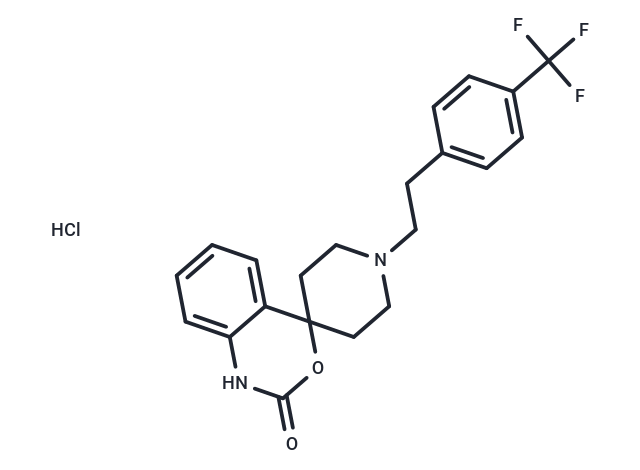Shopping Cart
- Remove All
 Your shopping cart is currently empty
Your shopping cart is currently empty

RS102895 hydrochloride is a potent antagonist of CCR2(IC50 of 360 nM).

| Pack Size | Price | Availability | Quantity |
|---|---|---|---|
| 2 mg | $40 | In Stock | |
| 5 mg | $60 | In Stock | |
| 10 mg | $90 | In Stock | |
| 25 mg | $189 | In Stock | |
| 50 mg | $337 | In Stock | |
| 100 mg | $506 | In Stock | |
| 1 mL x 10 mM (in DMSO) | $71 | In Stock |
| Description | RS102895 hydrochloride is a potent antagonist of CCR2(IC50 of 360 nM). |
| Targets&IC50 | α1A-adrenoceptor:130 nM, α1D-adrenoceptor (human):320 nM, CCR1:17800 nM, CCR2:360 nM, 5-HT1A:470 nM |
| In vitro | RS102895 hydrochloride is a potent antagonist of CCR2(IC50 : 360 nM). RS102895 inhibits human α1a and α1d receptors, rat brain cortex 5HT1a receptor in cells with IC50s of 130, 320, 470 nM, respectively. RS102895 suppresses wild type and D284N mutant MCP-1 receptor with IC50 of 550 nM and 568 nM, respectively. RS102895 less potently inhibits D284A MCP-1 receptor with IC50 of 1892 nM. RS102895 ameliorates the increased extracellular matrix (ECM) protein expression by inhibition of CCR2 at 10 μM, and obviously blocks fibronectin and type IV collagen protein expression in high glucose (HG)-stimulated mesangial cells (MCs) at 1 or 10 μM. RS102895 (10 μM) also abrogates the increased TGF-1 levels in MCs treated with MCP-1[2]. |
| In vivo | Progressive decrease in pain threshold in rats with bone cancer pain (BCP) at day 3-9 after surgery via intrathecal injection caused by RS102895 (3 g/L), but the pain threshold increases after 12 days. RS102895 also potently reverses the pattern of NR2B, nNOS, and SIGIRR expression in spinal cord[3]. |
| Molecular Weight | 426.86 |
| Formula | C21H22ClF3N2O2 |
| Cas No. | 1173022-16-6 |
| Smiles | Cl.FC(F)(F)c1ccc(CCN2CCC3(CC2)OC(=O)Nc2ccccc32)cc1 |
| Relative Density. | no data available |
| Storage | Powder: -20°C for 3 years | In solvent: -80°C for 1 year | Shipping with blue ice. | ||||||||||||||||||||||||||||||
| Solubility Information | DMSO: 28 mg/mL (65.6 mM), Sonication is recommended. | ||||||||||||||||||||||||||||||
Solution Preparation Table | |||||||||||||||||||||||||||||||
DMSO
| |||||||||||||||||||||||||||||||

Copyright © 2015-2025 TargetMol Chemicals Inc. All Rights Reserved.